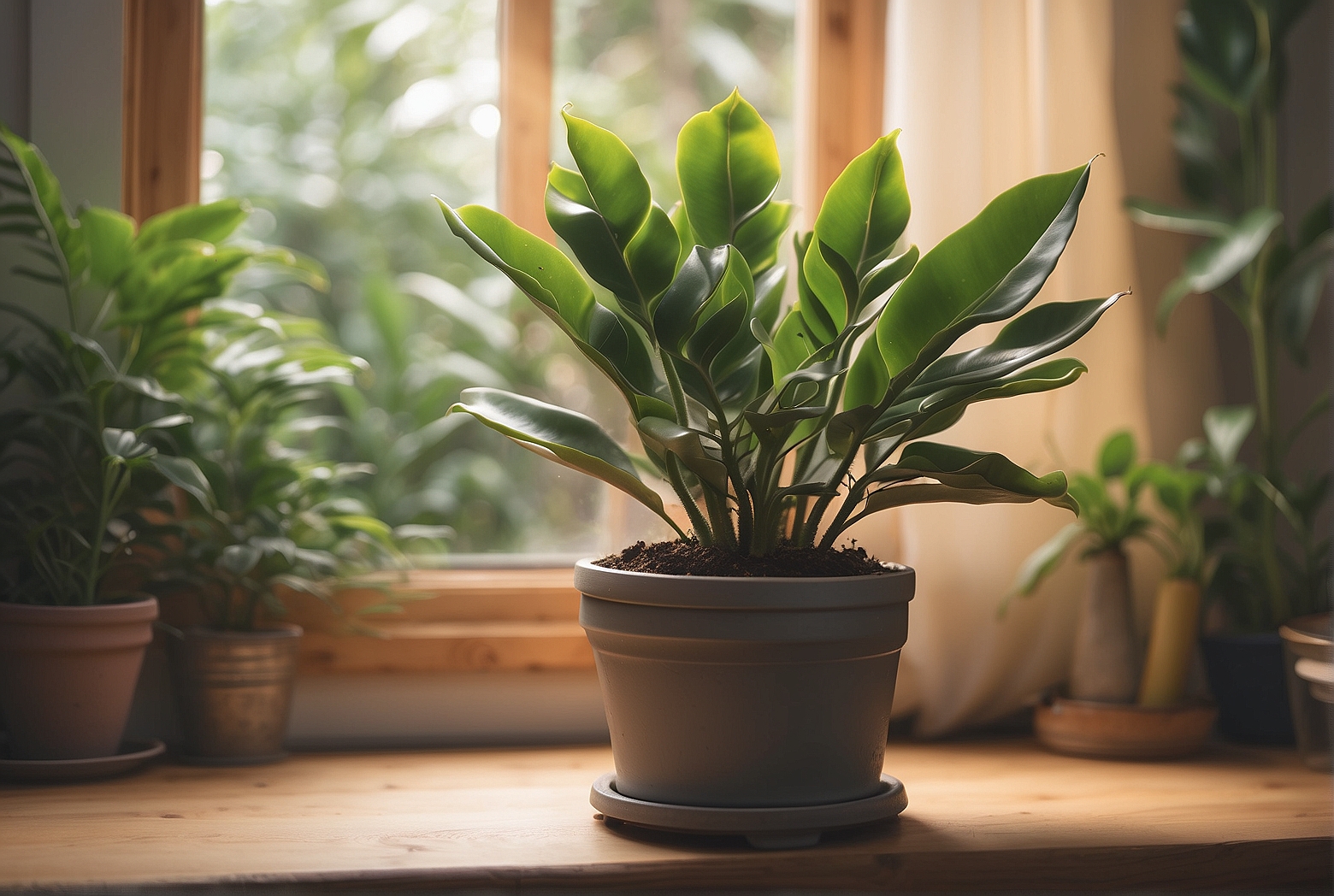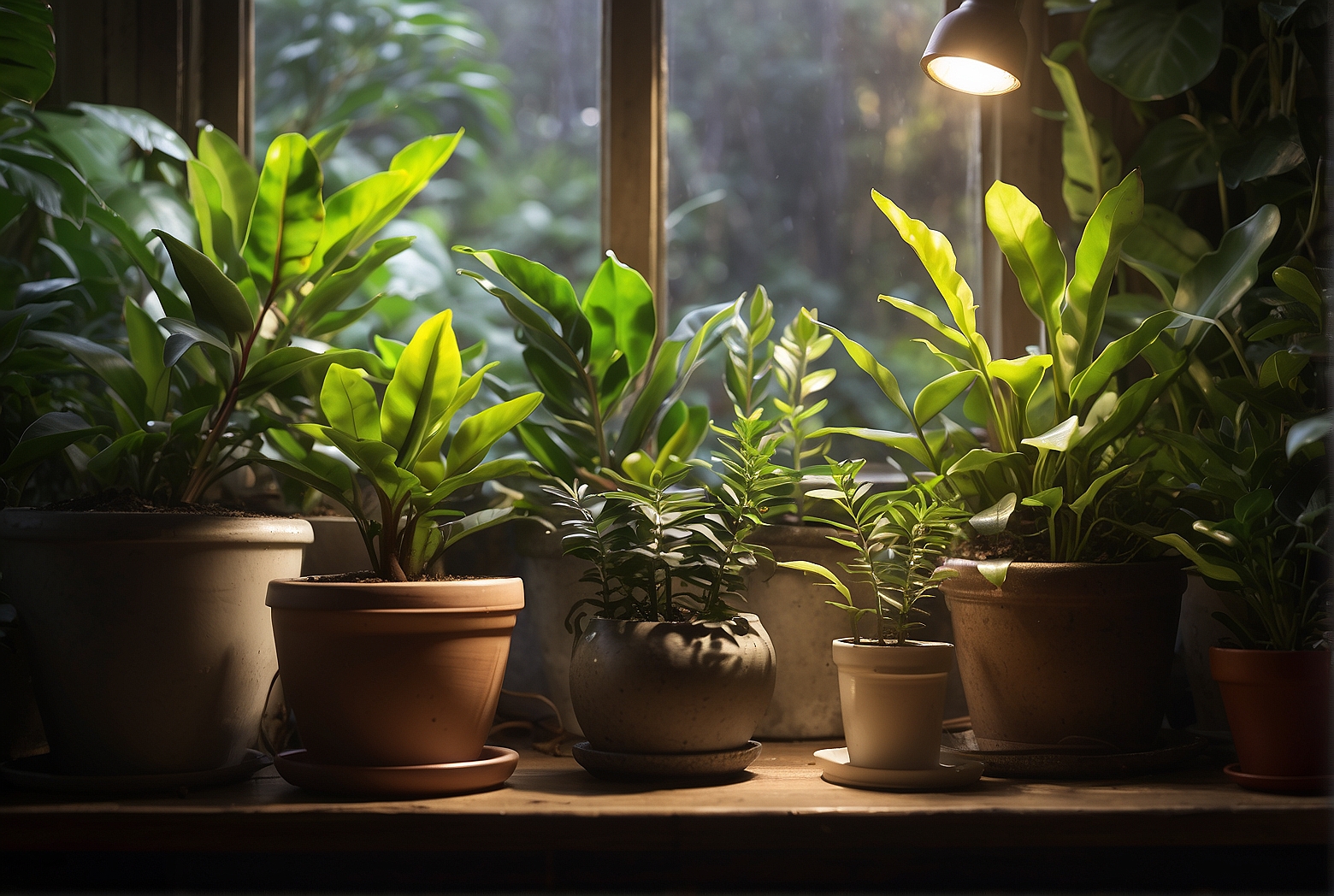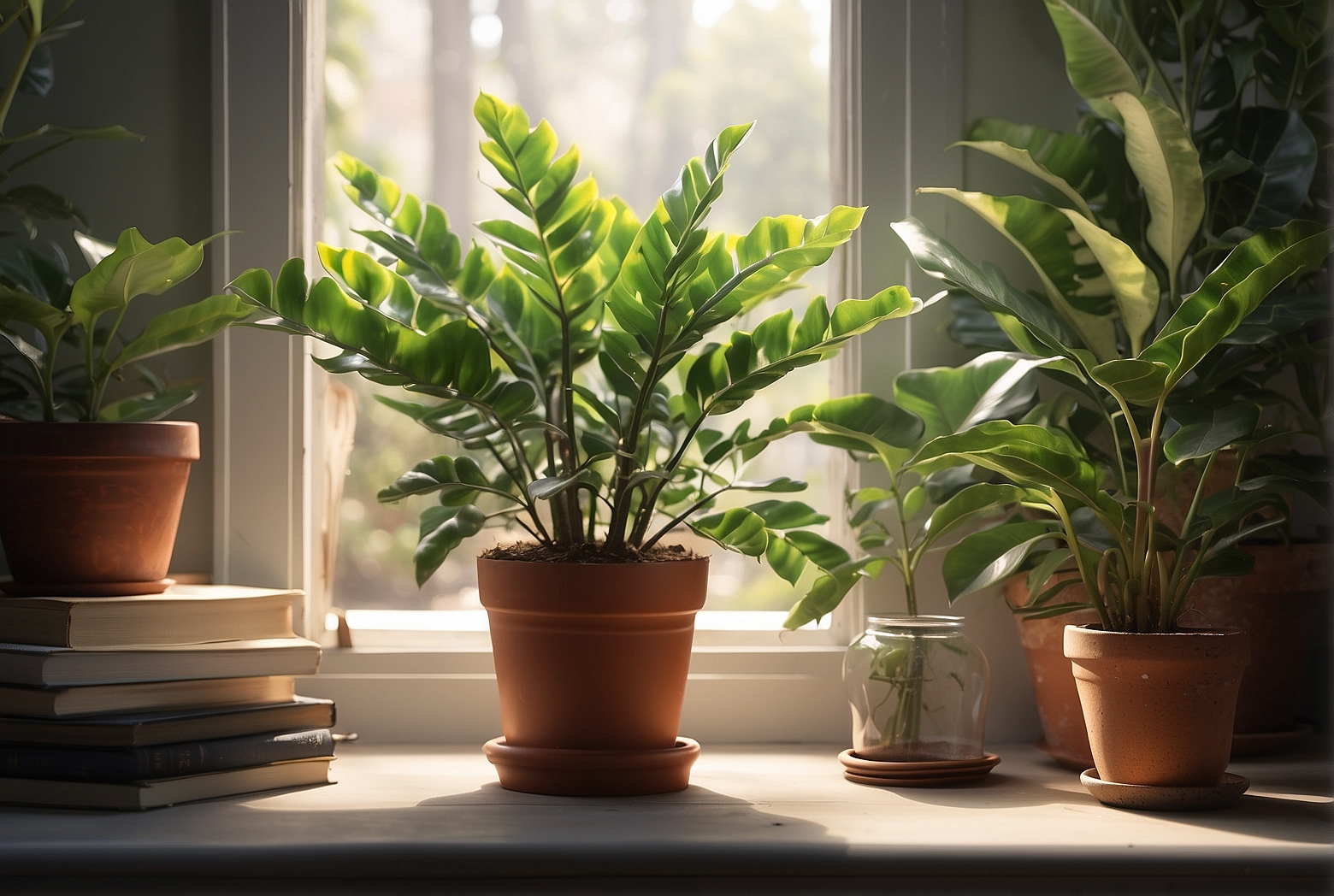Last Updated on March 29, 2024 by Tony Manhart
Are you a proud owner of a ZZ plant but unsure about how much light it actually needs? Well, you’re in the right place! In this article, we will guide you through the process of determining the perfect amount of light required for your beloved ZZ plant. By understanding the lighting needs of this popular houseplant, you can ensure its growth and well-being, allowing it to thrive in your home. So, let’s get started and shed some light on the subject!
1. Understanding the ZZ Plant
The ZZ Plant, also known as Zamioculcas zamiifolia, is a popular houseplant that is cherished for its attractive, glossy foliage and low-maintenance nature. This tropical plant originated from Eastern Africa and is well-loved for its ability to thrive in various light conditions. Understanding the characteristics of the ZZ Plant is essential for providing it with the ideal light conditions to ensure optimal growth and health.
Characteristics of the ZZ Plant
The ZZ Plant is recognized for its thick, fleshy stems and dark green, pinnate leaves. Its glossy foliage gives it a sophisticated and elegant appearance, making it a perfect addition to any indoor space. This plant is well-adapted to surviving in low-light conditions, making it an excellent choice for those seeking a resilient and forgiving houseplant. Its ability to store water in its thick roots allows it to withstand periods of neglect and makes it highly drought-tolerant.
2. Importance of Light for ZZ Plant
Photosynthesis and Light
As with all plants, light plays a crucial role in the growth and survival of the ZZ Plant. Light is a fundamental component of the photosynthesis process, where plants convert sunlight into energy to fuel their growth. Without sufficient light, the ZZ Plant will struggle to produce the energy it needs to thrive and may exhibit signs of inadequate light.

Light Requirements for Tropical Plants
Tropical plants, such as the ZZ Plant, generally thrive in the understory of forests where they receive filtered or dappled sunlight. They have adapted to lower light conditions by developing efficient photosynthesis mechanisms and strong chlorophyll absorption capabilities. While they can tolerate low light, they still require a certain level of light intensity and duration to support their overall health.
3. Assessing Light Conditions
Natural Light Sources
When determining the light conditions for your ZZ Plant, it is essential to consider the natural light sources available in your space. South-facing windows tend to provide the most intense light, followed by east and west-facing windows. North-facing windows typically receive the least amount of direct sunlight. Observe the duration and intensity of sunlight your ZZ Plant receives throughout the day to assess its natural light conditions accurately.
Indoor Light Options
If natural light sources are limited in your space, there are various indoor light options available to supplement the light requirements of your ZZ Plant. LED grow lights are an excellent choice due to their energy efficiency and customizable light spectrum. Compact fluorescent lights (CFLs) can also be used to provide sufficient light for your ZZ Plant. Place the light source within a reasonable distance from your plant to ensure proper light distribution.
Measuring Light Intensity
To measure light intensity, you can use a light meter, also known as a lux meter. These devices help determine the amount of light reaching your ZZ Plant. The optimal light intensity for a ZZ Plant is generally around 1500-2000 lux, although it can tolerate lower or higher levels depending on the specific variety and its adaptation to light conditions.

4. Ideal Light Conditions for ZZ Plant
Considerations for Placement
When determining the ideal light conditions for your ZZ Plant, consider its natural habitat. Mimicking its native environment to the best of your abilities will help promote healthy growth. Place your ZZ Plant in an area with bright, indirect light. Avoid placing it in direct sunlight, as this can cause leaf scorching and damage.
Light Intensity Requirements
The ZZ Plant thrives in moderate to low light conditions, making it suitable for areas with limited access to natural light. Aim for light intensities of approximately 1500-2000 lux, which can be achieved with indirect sunlight or supplemental grow lights. This range provides enough light for the ZZ Plant to carry out photosynthesis and sustain robust growth.
Light Duration and Photoperiod
In addition to light intensity, the duration of light exposure also influences the growth of your ZZ Plant. In its natural habitat, the ZZ Plant experiences varying day and night lengths. Ideally, provide your plant with 12-16 hours of light exposure each day to replicate its natural photoperiod. This duration allows the ZZ Plant to receive an adequate amount of light for photosynthesis while still having a period of darkness for rest.
5. Signs of Inadequate Light
Stunted Growth
Insufficient light can lead to stunted growth in ZZ Plants. If your plant is not receiving enough light, it may appear smaller than usual and have slower growth rates. The stems may also be weak and thin, unable to support the weight of the leaves.
Pale or Yellowing Leaves
When a ZZ Plant lacks the necessary light, its leaves may become pale or yellow. This is a common sign of chlorosis, a condition where the plant is unable to produce enough chlorophyll. Chlorophyll is essential for photosynthesis and gives leaves their green color. A lack of chlorophyll results in yellowing foliage.
Poor Overall Plant Health
Inadequate light conditions can weaken the overall health of your ZZ Plant, making it more susceptible to pest infestations and diseases. Without sufficient light, the plant’s immune system is compromised, leaving it unable to defend against external threats. A weakened plant may display symptoms such as wilting, leaf drop, and overall poor vitality.
6. Signs of Excessive Light
Leaf Scorching
Excessive light can also harm your ZZ Plant. When exposed to intense, direct sunlight for prolonged periods, the leaves may develop brown or yellow patches. This leaf scorching is a result of the plant’s inability to dissipate excess energy absorbed from the sun. If your ZZ Plant shows signs of leaf scorching, move it to a location with less intense light.
Unhealthy Darkening or Blisters on Leaves
In addition to leaf scorching, excessively high light levels can cause darkening or blister-like formations on the leaves of your ZZ Plant. These dark spots or blisters may appear as a result of localized damage from excessive light exposure. If you notice these symptoms, it is crucial to adjust the light conditions to prevent further damage.
7. Adjusting Light Levels
Moving the Plant
If you determine that your ZZ Plant is receiving inadequate or excessive light, consider moving it to a more suitable location. For areas with low light, place the plant closer to a window or choose a spot with brighter indirect light. If your plant is exposed to intense sunlight, move it to a shadier location or use sheer curtains or blinds to filter the light.
Using Curtains or Blinds
To prevent excessive light exposure, you can use curtains or blinds to filter and diffuse the incoming sunlight. Sheer curtains or blinds allow light to enter while reducing its intensity. Adjust the curtains or blinds throughout the day to match the changing intensity of sunlight and provide your ZZ Plant with a suitable light level.
Using Artificial Lights
In spaces with limited natural light, consider using artificial lights to supplement the ZZ Plant’s light requirements. LED grow lights or CFLs can be used to provide the necessary light intensity and duration. Position the lights at an appropriate distance from the plant to ensure even light distribution and avoid overheating.
8. Caring for the ZZ Plant in Low Light
Tolerating Low Light Conditions
The ZZ Plant is known for its ability to tolerate low light conditions. While it may not thrive in such environments, it can still survive with minimal light exposure. If you have limited access to natural light, choose a ZZ Plant variety specifically bred for lower light conditions, such as the ZZ Plant “Raven” or “Zamicro.”
Adjustments to Care Routine
In low light conditions, the ZZ Plant’s growth may slow down, and its water requirements decrease. Adjust your care routine by watering the plant less frequently to prevent overwatering. Also, avoid using fertilizer as the plant’s reduced metabolic rate may result in nutrient buildup.
9. Caring for the ZZ Plant in High Light
Protection from Direct Sunlight
When caring for your ZZ Plant in high light conditions, protecting it from direct sunlight is crucial. Place the plant in a location that receives bright, indirect light, such as near a north or east-facing window. If direct sunlight does reach the plant, use sheer curtains or blinds to filter the light and prevent leaf scorching.
Providing Shade and Diffused Light
If your space has intense sunlight throughout the day, you may need to provide additional shade for your ZZ Plant. Use sheer curtains, shade cloth, or sheer plant covers to create a diffused light environment. This will allow the plant to receive adequate light while reducing the intensity and preventing leaf damage.
10. Regular Monitoring and Adaptation
Observing and Evaluating Plant Response
Regularly monitor your ZZ Plant’s growth and observe its response to the light conditions provided. Pay attention to any changes in leaf color, growth rate, and overall plant health. By closely observing your plant’s response, you can make necessary adjustments to ensure its optimal growth and well-being.
Making Adjustments as Needed
Based on your observations, make appropriate adjustments to the light levels your ZZ Plant receives. Move the plant to a different location, adjust the position of curtains or blinds, or modify the duration of artificial light exposure. By continuously adapting the light conditions, you can create an ideal environment that allows your ZZ Plant to flourish.
In conclusion, understanding the light requirements of your ZZ Plant is crucial for its overall health and growth. By assessing light conditions, providing appropriate intensity and duration, and making necessary adjustments, you can create an ideal environment for your ZZ Plant to thrive. Regular monitoring and adaptation ensure that your plant receives the optimal amount of light, resulting in a happy and vibrant ZZ Plant.
Tony Manhart is a passionate gardener who has been tending to gardens for over 20 years. He takes pride in creating beautiful outdoor spaces with plants, trees, and shrubs that can thrive in any environment. He loves to share his knowledge with others and has taught classes on gardening basics and advanced techniques. He is committed to sustainability, using natural and organic methods to create and maintain gardens. He also works with local organizations to create green spaces for communities. When he’s not gardening, Tony enjoys hiking, reading, and spending time with his family.

